Ch 6: Behavior Problems
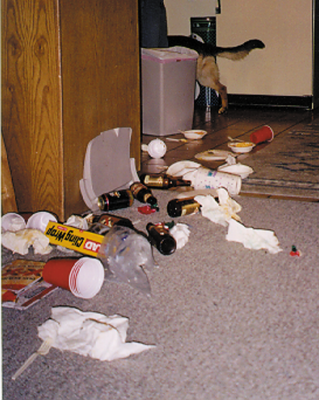
Why do dogs misbehave? Or, perhaps we should ask, do dogs misbehave? Certainly, dogs are dogs, and unless given appropriate guidance, puppies will grow up to behave like dogs. However, most behavior problems that irritate owners are, in fact, perfectly normal, natural and necessary canine behaviors. From a dog’s point of view, it is as normal to bark, chew, dig and urine-mark as it is to wag a tail or bury a bone. Moreover, just as it is a physiological necessity for dogs to urinate and defecate, it is a psychological necessity for dogs occasionally to bark, howl, chew, sniff, dig, run, jump, chase and play. Obviously, dogs have an inherent need, desire, drive, or motivation to act like dogs. So, the dog's behaviors per se are quite normal and utterly necessary, rather it is their manner of expression that is inappropriate. Well, here again, dogs might disagree. I am lucky to be fluent in several canine languages — including Labradorian, Malamutian and Yorkiese — and Labradors have convinced me that they consider it perfectly appropriate to jump-up, knock over folding chairs, pounce in mud puddles, and socialize with a fallen leaf, just as Malamutes and Yorkies have taught me that it is entirely acceptable and even expected to howl in the middle of the night and to pee on carpets (so as not to get one’s feet wet). So, dogs consider their behavior to be both appropriate and acceptable, rather it is owners who consider some dog behaviors to be inappropriate and unacceptable. Since people have invited dogs into their human homes, and since people (and not dogs) consider some dog behaviors to be inappropriate and unacceptable, then people should do their best to understand and respect dogs as dogs and to try and understand their point of view, yet to teach them how to express their natural dogginess in a manner that does not frustrate or offend their human housemates. It is unrealistic to expect all dogs to grow up automatically to behave like Lassie. (“Lassie” was in fact several highly trained dogs.) If owners understandably have rules and regulations as to how they would like their dog to behave, they should not keep these rules a secret from the dog. Otherwise, the poor dog will predictably break rules that he didn't even know existed and no doubt, be punished for these inevitable “transgressions.” Owners must teach dogs how to express their basic doggy nature in a manner that is both acceptable and appropriate within the domestic setting. The owner must at least meet the dog halfway and establish a mutually agreeable arrangement vis a vis the dog's conduct in urban, suburban and rural neighborhoods. Otherwise, the dog will be left to improvise in his endless quest for some kind of occupational therapy to pass the time of day and most likely, the owners will take considerable exception to the dog's selection of activities and entertainment. Specifically, owners should teach their dogs what to chew, where to eliminate, where to dig, when and for how long to bark, how to enjoy spending time at home alone, when to pull on leash, when and how to be hyperdog, and especially how to greet, socialize and play with other dogs and people.
Housesoiling
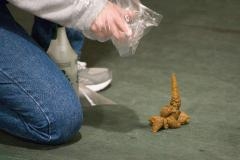
Housesoiling is a spatial problem. Your puppydog has been allowed to eliminate in the wrong place. Housesoiling quickly becomes a bad habit because dogs develop strong location, substrate, and olfactory preferences for their improvised indoor toilet areas. To housetrain your puppydog: first, prevent any more mistakes; and second, teach your puppydog where you would like him to eliminate.
Prevent Mistakes
Mistakes are a disaster since they set a bad precedent and create bad habits, which can be hard to break. Consequently, you must prevent mistakes at all cost. Whenever you are not at home, leave your dog in a long-term confinement area, such as a single room indoors with easy-to-clean floors (bathroom, kitchen, or utility room)—this will be your puppydog’s playroom.
Provide your dog with fresh water, a number of stuffed chewtoys for entertainment, a comfortable bed in one corner, and a doggy toilet in the corner diagonally opposite from his bed. Your dog will naturally want to eliminate as far as possible from his bed, and so will soon develop the good habit of using his toilet. And remember, good habits are just as hard to break as bad habits.
For a doggy toilet, use sheets of newspaper sprinkled with soil, or a litter box filled with a roll of turf, or a concrete paving slab. Thus your dog will develop olfactory and substrate preferences for eliminating on soil, grass, or concrete.
The purpose of long-term confinement is to confine your dog’s natural behaviors (including urinating and defecating) to an area that is protected (thus preventing any mistakes around the house when you are not there), and to help your dog quickly develop a strong preference for eliminating on soil, grass, or concrete.
Teach Your Dog to Eliminate in the Right Place
When you are at home, confine your dog to a short-term confinement area with a number of stuffed chewtoys for entertainment. A portable dog crate makes an ideal doggy den. Alternatively, keep your dog on a short leash fastened to an eye-hook in the base board near her bed, or attach the leash to your belt. This way your dog may settle down beside you while you read, work at the computer, or watch television.
Every hour on the hour, say "Let’s go pee and poop" (or some other appropriate toilet instruction), and hurry your dog (on leash) to her toilet (in your yard, or at curbside outside the front door of your house or apartment building). Stand still with your dog on leash and repeat the instruction to eliminate. Give your dog three minutes to empty herself.
When your dog eliminates, praise her enthusiastically and offer three freeze-dried liver treats. Most puppies will urinate within two minutes on each trip to a toilet area, and defecate within three minutes on every other trip. Once your dog realizes that she can cash in her urine and feces for tasty treats, she will want to eliminate in her toilet area. Soiling the house just does not have comparable fringe benefits. Moreover, after a dozen or so repetitions, you will have taught your dog to eliminate on command.
If your dog does not eliminate during the allotted three-minute toilet break, put her back inside her crate for another hour.
The purpose of short-term close confinement is to prevent any mistakes around the house when you are home (but cannot devote undivided attention to your dog) and to predict when your dog needs to eliminate. Temporarily (for no more than an hour at a time) confining a puppydog to a small space (e.g., a dog crate) inhibits elimination, since the dog does not want to soil her sleeping area. Consequently, your dog will want to go immediately upon release from confinement—especially since hurrying to the toilet area will jiggle her bladder and bowels. Since you choose when to release your dog, you may choose when your puppy eliminates, and since you can predict when your dog needs to eliminate, you may be there to show her where to go, to reward your dog for going, and to inspect and immediately clean up after your dog.
Never confine a puppy or an unhousetrained adult dog to a crate for longer than an hour. A dog confined too long will be forced to soil her crate, making her extremely difficult to housetrain.
Once your pup is old enough to go on walks, make sure she eliminates (in the yard, or in front of your house) before each walk. If your dog does not go within three minutes, put her back in her crate and try again an hour later. However, if your dog does go, praise and reward her as usual and then say “Let’s go for a walk.” With a no-feces/no-walk policy, you will soon have a very speedy defecator. Moreover, elimination close to home facilitates clean-up and disposal; you will not have to stroll the neighborhood weighed down with a bag of doggie doo.
If you require a more detailed description of housetraining, download BEFORE You Get Your Puppy. To housetrain your dog, you need a dog crate, a number of chewtoys, and some freeze-dried liver treats. All of these products are available from your local pet store.
Destructive Chewing
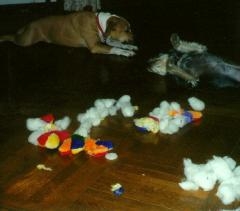
Chewing is essential for maintaining the health of your dog's teeth, jaws, and gums. Puppies especially have a strong need to chew to relieve the irritation and inflammation of teething. Dogs chew to relieve anxiety and boredom, as well as for entertainment. Your dog’s jaws are his tools for carrying objects and for investigating his surroundings. Essentially, a dog’s approach to all items in his environment is “Can I chew it?”
Chewing is Normal, Natural, and Necessary
Dogs generally sleep at night and in the middle of the day. However, chewing is your dog’s primary form of entertainment during his morning and late afternoon activity peaks. After all, there are only so many things your dog can do when left at home alone. He can hardly read a novel, telephone friends, or watch the soaps! Indeed, most chewing sprees stem from your dog's relentless quest for some form of occupational therapy to pass the time of day when left at home alone.
Chewing is a perfectly normal, natural, and necessary canine behavior. Prevention and treatment of destructive chewing focus on management and education—to prevent your dog from chewing inappropriate items and to redirect your dog's natural chewing-urge to appropriate, acceptable, and resilient chewtoys.
Prevent Destructive Chewing
When leaving home, confine your puppydog to a long-term confinement area, such as a single room—your puppydog’s playroom—with a comfortable bed, a bowl of water, a doggy toilet (if not yet housetrained), and nothing to chew but half a dozen freshly-stuffed chewtoys. Housetrained adult dogs may be confined (with their chewtoys) to a dog crate. When you return, instruct your dog to fetch his chewtoys so you can extricate the freeze-dried liver pieces and give them to your dog. Your dog will happily settle down and entertain himself with his chewtoys as soon as you leave in the morning, and he will be more inclined to search for chewtoys when he wakes up in anticipation of your afternoon return. This is important since most chewing activity occurs right after you leave home and right before you return.
When you are home, confine your puppy to her doggy den (crate) with nothing but a freshly-stuffed chewtoy for entertainment. Every hour on the hour (or at longer intervals with housetrained adult dogs), take your puppydog to her doggy toilet (see Housetraining blueprint), and if she goes, praise her and play some chewtoy games with her before putting her back in her crate with a freshly stuffed chewtoy.
The purpose of confinement is to prevent your dog from chewing inappropriate items around the house and to maximize the likelihood your dog will develop a chewtoy habit.
Redirect Chewing to Chewtoys
The confinement schedule described above optimizes self-training; your dog will train herself to chew chewtoys. In fact your dog will soon become a chewtoyaholic. With a good chewtoy habit, your puppy will no longer want to destroy carpets, curtains, couches, clothes, chair legs, computer disks, children's toys, or electrical cords. Your dog will be less likely to develop into a recreational barker. And also, your dog will happily settle down calmly and quietly and will no longer be bored or anxious when left alone.
You must also actively train your dog to want to chew chewtoys. Offer praise and maybe a freeze-dried liver treat every time you notice your dog chewing chewtoys. Do not take chewtoy chewing for granted. Let your dog know that you strongly approve of her newly acquired, appropriate, and acceptable hobby. Play chewtoy games with your dog, such as fetch, search, and tug-of-war.
Chewtoys should be indestructible and nonconsumable. Consumption of non-food items is decidedly dangerous for your dog's health. Also, destruction of chewtoys necessitates their regular replacement, which can be expensive. However, compared with the cost of reupholstering just one couch, $70 worth of chewtoys seems a pretty wise investment.
Kongs, Biscuit Balls, Squirrel Dudes, Busy Buddy Footballs, and sterilized long-bones are by far the best chewtoys. They are made of natural products, are hollow, and may be stuffed with food to entice your dog to chew them exclusively. To prevent your dog from porking out, ensure that you only stuff chewtoys with part of your dog's daily diet (kibble or raw food). Firmly squish a piece of freeze-dried liver in the small hole in the Kong, fill the rest of the cavity with moistened kibble, and then put the Kongs in the freezer. Voila, Kongsicles! As the kibble thaws, some falls out easily to reinforce your dog as soon as she shows interest. Other bits of kibble come out only after your dog has worried at the Kong for several minutes, thus reinforcing your dog's chewing over time. The liver is the best part. Your dog may smell the liver, see the liver, (and maybe even talk to the liver), but she cannot get it out. And so your dog will continue to gnaw contentedly at the Kong until she falls asleep.
Until your dog is fully chewtoy-trained, do not feed her from a bowl. Instead, feed all kibble, canned food, and raw diets from chewtoys, or handfeed meals as rewards when you notice your dog is chewing a chewtoy.
If you would like better insight into your dog’s chewing psyche, read Chapter 3, "It’s All Chew Toys to Them," in The Culture Clash by Jean Donaldson. If you require a more detailed description of chewtoy training, download BEFORE You Get Your Puppy. To chewtoy train your dog, you need a dog crate, a number of hollow chewtoys, and some freeze-dried liver treats. All of these products are available from your local pet store.
Excessive Barking
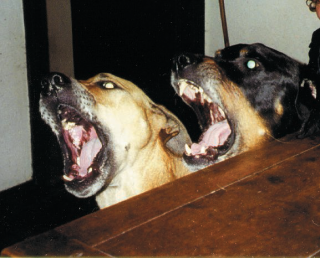
Some dogs get extremely worked up when visitors ring the doorbell, or when dogs walk by the house. Some spaniels and terriers bark at the drop of a hat. And our good friend Larry Labrador will bark whenever a leaf falls from a tree three blocks away. Barking is as characteristically doggy as wagging a tail or burying a bone. It would be inane and inhumane to try to stop your dog from barking altogether: "You’ll never bark in this town again!" After all, some barking is extremely useful. My dogs are much more efficient than the doorbell and much more convincing than a burglar alarm. The goal then, is to teach dogs normally to be calm and quiet but to sound the alarm when intruders enter your property. The barking problem may be resolved to our advantage by management and education: first, immediately reduce the frequency of barking before we all go insane; and second, teach your dog to "Woof" and "Shush" on cue.
Reduce the Frequency of Barks
Dogs bark the most right after their owners leave home for the day. The easiest way to immediately reduce woof-frequency is by exclusively feeding your dog from hollow chewtoys. Each evening weigh out and moisten your dog’s kibble or raw diet for the following day. Squish the gooey food into hollow chewtoys (Kong products and sterilized bones) and put them in the freezer overnight. In the morning, give your dog some frozen stuffed chewtoys. Your dog will spend well over an hour extricating his breakfast from the chewtoys. And if your dog is busying himself with chewtoys, he will be lying down quietly!
Do not leave an excessive barker outdoors. Yard-bound dogs are exposed to many more disturbances and their barks more easily penetrate the neighborhood. Leave your dog comfortably in a single room (away from the street) with a radio playing to mask outside disturbances. If you have been leaving your dog outside because he soils or destroys the house, housetrain and chewtoy train your dog so he may enjoy indoor comforts when you are away from home.
Teach "Woof" and "Shush" On Cue
It is easier to teach your dog to shush when he is calm and focused. Therefore, teaching your dog to "Woof" on cue is the first step in "Shush" training, thus enabling you to teach "Shush" at your convenience, and not at inconvenient times when the dog decides to bark. Moreover, teaching "Shush" is now much easier because your dog is not barking uncontrollably — barking was your idea!
Station an accomplice outside the front door. Say "Woof" (or "Speak," or "Alert"), which is the cue for your assistant to ring the bell. Praise your dog profusely when he barks (prompted by the doorbell); maybe even bark along with your dog. After a few good woofs, say "Shush" and then waggle a tasty food treat in front of his nose. Your dog will stop barking as soon as he sniffs the treat because it is impossible to sniff and woof simultaneously. Praise your dog as he sniffs quietly, and then offer the treat.
Repeat this routine a dozen or so times and your dog will learn to anticipate the doorbell ringing whenever you ask him to speak. Eventually your dog will bark after your request but before the doorbell rings, meaning that your dog has learned to bark on command. Similarly, your dog will learn to anticipate the likelihood of sniffables following your "Shush" request. You have then taught your dog both to speak and shush on cue.
Over repeated "Woof" and "Shush" trials, progressively increase the length of required shush-time before offering a food reward — at first just two seconds, then three, then five, eight, twelve, twenty, and so on. By alternating instructions to woof and shush, the dog is praised and rewarded for barking on request and for shushing on request.
Remember, always speak softly when instructing your dog to shush, and reinforce your dog's silence with whisper-praise. The more softly you speak, the more your dog will be inclined to pay attention and listen (and therefore, not bark).
Teach Your Dog When to Bark
Invite a dozen people for afternoon tea to teach your dog when, and when not, to bark. Instruct your visitors (some with dogs) to walk by the house a number of times before ringing the doorbell. When the first person walks by the house, it will take all of your attention to keep your dog shushed. But persevere: it will be easier when the same person walks by the second time, and again easier on the third pass by. Eventually your dog will habituate and will no longer alert to the same person's presence in the street. Profusely praise your dog and offer treats for silent vigilance. Repeat reinforcement for quiet vigilance several times on subsequent passes by. But when the visitor starts up the garden path, eagerly and urgently say "Speak! Speak! Speak!" Praise your dog when he woofs, and then instruct him to sit and shush at the front door while you welcome the visitor. If your dog exuberantly barks and bounces at this point, simply wait until he sits and shushes and then praise and offer a treat. Have the visitor leave and come back a number of times. Eventually, your dog will greet him by sitting in silence. This procedure becomes easier with each new visitor. Your dog soon learns to watch passersby in silence and to give voice when they step on your property, but to sit and shush when they are invited indoors—a trained neighborhood watchdog, which even non-dog-owning neighbors will welcome on the street where they live.
If you require a more detailed description, read Dr. Dunbar’s Good Little Dog Book. To teach your dog to be calmer and bark less, you will need numerous stuffable chewtoys. To teach your dog to "Woof" and "Shush" on cue, you need some freeze-dried liver treats. All of these products are available from your local pet store.
Digging
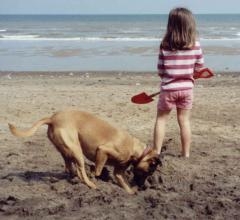
Dogs dig to bury bones, and later to dig them up again. Dogs dig cooling hollows in the summer, and warming pits in the winter. Dogs dig after eavesdropping on private ultrasonic conversations of subterranean critters. Bitches dig dens when they are pregnant. Dogs dig out of boredom, and dogs dig to escape. But by and large, most dogs dig for the sheer fun of it.
Dogs Don’t See Your Problem
Dogs consider digging to be a perfectly normal and natural doggy activity. In fact, terriers consider digging to be their very reason for being. It would therefore be fruitless to try to stop your dog from digging altogether. Prevention and treatment of misplaced digging focus on management and education: preventing your dog from digging in inappropriate areas and redirecting your dog's natural digging-desire to a suitable area.
Prevent Digging in Your Absence
When you are away from home, keep your dog indoors. When you are at home, try your best to accompany your dog outdoors to supervise and teach garden rules.
Housesoiling, destructive chewing, and hyperactivity are the most common reasons why dogs are relegated to unsupervised, solitary confinement in the yard, where they predictably learn to bark, dig, and escape, and become over-excited whenever let indoors. Consequently, it is important to housetrain and chewtoy-train your dog. (See Housetraining and Destructive Chewing) Teach your dog to settle down calmly and quietly indoors, and to sit when greeting visitors (see HyperDog!). Then your dog may remain safely indoors whether you are home or not. Your air-conditioned and centrally-heated house is the safest and most comfortable place for your dog to spend the day. When you are at home, go outside and enjoy your garden with your dog.
Some dogs dig to escape because they cannot bear the boredom and anxiety of solitary confinement in the yard. Escaping is exceedingly dangerous for your dog's health. So if you decide to leave your dog in the yard, make the yard more interesting and be sure to fix the fence. Also make sure your dog has a cool resting place in the summer and warmth in the winter. Teach your dog to dissipate digging energy with other activities. Make sure your dog is well exercised (psychologically as well as physically) and entertained, and thus has no need to dig to escape from the yard. Teach recreational diggers to become recreational chewers. If your dog is busying himself with a chewtoy, he has little time to dig. Consequently, chewtoys stuffed with breakfast kibble are the best objects to leave indoors, or to bury in your dog’s digging pit. You must teach your dog how to entertain himself outdoors. This means your dog needs chewtoys outside, too.
Redirect Digging to a Digging Pit
Since you consider your dog’s choice of digging locations to be inappropriate, choose a location to your liking and teach your dog to dig there. Build your dog a digging pit (much like a child’s sandbox) in a suitable corner of the yard.
Bury a cow's femur (the whole thing) in your dog's digging pit. Your little doggie will be utterly delighted when she finds a huge meaty bone. Now, this single simple procedure may not totally prevent holes in other areas of the garden, but your dog will now be much more inclined to dig in her digging pit. I mean, in 1849 everyone started rushing westwards to California. They didn't rush to New Jersey. And why did they rush to California? Because one person discovered a nugget of gold at Sutter's Mill. They didn't find gold in New Jersey, and so they didn’t rush to New Jersey. And so it is with dogs. After just one remarkable find, your dog will prefer to excavate in that California corner—her digging pit, where she once found something very worth finding.
Every morning, fill several chewtoys with your dog’s breakfast kibble and bury them in her digging pit. Your dog will discover that the digging pit is a virtual treasure trove where she can find toys for sustenance and entertainment.
Garden Rules
Once the dog's digging activities have been redirected to a suitable location in your yard, you might consider protecting other parts of the garden. Lay down chicken wire or chain-link fencing over the lawn and flower beds, add plenty of topsoil, and reseed.
Use boundary fences to partition the yard into doggy and non-doggy zones. The fences are not meant to be dog proof; rather, they are used as training aids to clearly demarcate lawn and garden boundaries to help you teach the rules. Always try to accompany your dog when he goes outside, especially during puppyhood or the first few months an older dog is at home. Remember, an owner in the yard is worth two in front of the television! It is not fair to keep garden rules a secret from your dog and then get angry with the dog for breaking rules he didn’t even know existed. Encourage and praise your dog for walking on paths and for lying down in dog zones. Tie a number of stuffed chewtoys to ground stakes or hang them from tree branches in dog zones to encourage your dog to want to spend time in those areas. Discourage your dog from entering non-doggy zones.
To teach your dog to use a digging pit, you will need numerous stuffable chewtoys and some freeze-dried liver treats. These products are available from your local pet store.
Photo of Cleo and friend enjoying some joint digging courtesy of Sue Harbon. Thanks Sue!
Separation Anxiety
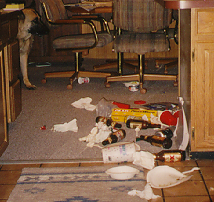
Your new puppydog needs lots of attention (companionship, education, and play), but also to be taught how to entertain himself appropriately and how to thoroughly enjoy his time when left at home alone. Otherwise, a social vacuum can be a very lonely place.
Puppies and dogs predictably develop housesoiling, chewing, digging, and barking problems if allowed too much freedom and too little supervision and guidance during their first few weeks at home. Puppies and newly adopted dogs may become overdependent if allowed unrestricted access to their owners during the initial time in their new home. Overdependent dogs often become anxious when left at home alone, and they attempt to adapt to the boredom and stress of solitary confinement by busying themselves with doggy activities—chewing, digging, barking—which soon become owner-absent behavior problems. What else is there to do? Severely stressed dogs may work themselves up into a frenzy and spend the day circling, pacing, and panting.
A Special Place
Dogs are den animals, and they value their own special place — a place for peaceful retreat, a methodical chew, or even a snooze. A doggy den (a collapsible and portable dog crate and dog bed) is an ideal training tool. Apart from its obvious uses for transporting dogs by car or plane, a crate may be used for short-term confinement when you cannot supervise your puppydog—to keep him out of mischief and prevent him from making housesoiling, destructive chewing, and digging mistakes. In addition, the crate may be used specifically to create good household habits: to housetrain your puppydog; to establish a hard-to-break chewtoy habit; to reduce excessive barking; to prevent inappropriate digging; and to foster confidence and calmness.
Right from the outset, when you are home, regularly confine your pup for "little quiet moments" in his dog crate in order to teach household manners and imbue confidence. Then your dog can look forward to enjoying a lifetime with the full run of your house, whether you are home or not.
Teach Your Puppydog to Enjoy His Doggy Den
A dog crate is really no different than a child's crib, playpen, or bedroom. The first item on the agenda is to teach your puppydog to thoroughly enjoy spending time in his doggy den. Stuff your puppy's first meal into a hollow chewtoy (see Chewing), tie the chewtoy inside the crate, and leave the door open so the pup may come and go as he pleases. Praise your puppy while he chews the chewtoy and supervise the puppy if he leaves the crate. Once the pup has settled down for a quiet chew, you may close the crate door. For your pup's second meal, put the stuffed chewtoys inside the crate and shut the door with the puppy on the outside. Once your puppy worries at the crate to get to his dinner, let the puppy enter his crate and close the door behind him. From now on, always give your puppy a stuffed chewtoy when confining him to his crate. Your pup will soon learn that confinement is for a short time—and an enjoyable time.
Teach Your Dog to Teach Herself
When at home, always confine your puppydog with a variety of hollow chewtoys stuffed with kibble and treats. Confining a dog to a crate with an attractive chewtoy is like confining a child to an empty room with a video game. This is called autoshaping. All you have to do is set up the situation, and your dog will automatically train herself. Each treat extricated from the chewtoy progressively reinforces chewing chewtoys and settling down calmly and quietly. Your dog will soon become hooked on her chewtoy-habit, leaving very little time for inappropriate chewing, digging, or barking. And if your puppydog is happily preoccupied chewing her chewtoy, she will fret less.
Housetraining
A dog crate may be used to predict when your puppy needs to relieve herself. Regular, but short-term (one hour or less) confinement inhibits your puppy from eliminating. This means that she will want to eliminate immediately when released each hour and taken to her toilet area, where she is handsomely rewarded with tasty training treats. However, never confine your unhousetrained puppy to her crate for longer than an hour, or when you are away from home; otherwise, the poor pup may be forced to soil her bedroom. As a temporary necessity until your puppy is housetrained, leave her in a special long-term confinement area. (See Housetraining)
Home-Alone Dogs Need An Occupation
Preparing dogs for inevitable periods of solitary confinement—and specifically teaching them how to occupy their time when left at home alone—is the most pressing humane consideration for any new puppydog in any household. Every dog requires some form of enjoyable occupational therapy. Vocational chewtoy chewing is the easiest and most enjoyable solution.
Dogs are crepuscular (most active at dawn and dusk), and so it is pretty easy to teach them how to calmly pass the time of day. During your puppydog's first few days and weeks at home, regularly confine him to a crate with stuffed chewtoys. Prepare the pup for your absence when you are present. When at home, it is possible to monitor your pup's behavior when confined for numerous short periods throughout the day. Your puppydog's first impressions of an established daily routine create an acceptable and enjoyable status quo for years to come. Remember, once your puppydog is confident, independent, and trained, he may enjoy free range of your house and garden for the rest of his life.
If you require a more detailed description, read AFTER You Get Your Puppy. To teach your dog to be calmer and bark less, you will need a dog crate, a number of hollow chewtoys, and some freeze-dried liver treats. All of these products are available from your local pet store.
To read this information in Ukrainian please click here. Thank you Sofya!
To read this information in Portuguese please click here. Thank you Artur!
Fearfulness
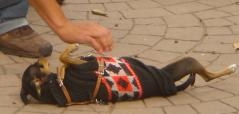
Socializing a puppy to people is the easiest and most enjoyable aspect of raising a dog. On a regular and ongoing basis, puppies need to meet, play with, and be handled and trained by a wide variety of people, especially including strangers, men, and children.
Narrow Window of Opportunity
Old dogs can indeed be taught new tricks. An adult dog may learn basic manners and good behavior (where to eliminate, what to chew, and when and for how long to bark) at any time in his life. However, socialization must occur during puppyhood—during the critical period of socialization, which ends when puppies are 12–13 weeks old. Shy and fearful dogs can be substantially rehabilitated, but they will never develop the confidence and social savvy of a well-socialized puppy. They will never become what they could have been.
Puppy socialization is critical for your puppy to develop the confidence and social savvy to continue socializing with people as an adult dog. Unless your puppy meets unfamiliar people every day, it will become fearful.
After eight weeks of age, puppies start to become shy and wary of unfamiliar people, and between five and eight months of age, they become fearful of strangers, especially men and children. Fearfulness and aggression worsen very quickly, because once a dog becomes fearful or aggressive, socialization stops. If your puppy becomes fearful, his life as a companion dog will be riddled with anxiety and stress and he will be useless as a working, competition, or protection dog.
If you notice any signs of shyness, standoffishness, or fearfulness in your puppy or adolescent dog, seek help immediately. Contact the Association of Pet Dog Trainers (1–800 PET DOGS or www.apdt.com to locate a Certified Pet Dog Trainer (CPDT) in your area.
Neonatal Handling
There is no better time to accustom puppies to enjoy being handled than when they are still neonates. The puppies cannot see or hear, but they can taste, smell, and feel. The puppies recognize and accept the handlers as strangers. What could be easier that inviting friends and family to gently hold, handle, and stroke neonatal puppies? Additionally, the ideal time to accustom puppies to sudden movements and loud, strange, and sudden noises is when the eyes and ears begin to open (between two and three weeks).
Socialization in the Puppy's Original Home
To fully enjoy life as a human companion, a puppy must be taught to thoroughly enjoy the company and actions of all people, especially strangers, men and children. It is not sufficient for puppies to meet the same small circle of familiar friends each day. Puppies need to meet unfamiliar people every day—especially men and children. Before they are eight weeks old—and the critical period of socialization is almost two-thirds over—puppies need to have been handled and trained by at least 100 different people. Puppy socialization and handling exercises are so simple, so important, and so much fun. Each person should use kibble to lure-reward each puppy to come, sit, lie down, and roll over. Then visitors can pick up, cradle, cuddle, and stroke the pups, while looking in their eyes and gently examining their jaws, paws, ears, belly, and private parts.
Remember to maintain routine hygiene: All people should leave outdoor shoes outdoors and wash their hands before handling puppies less than 12 weeks of age.
Socialization in the PuppyDog's New Home
By eight weeks of age socialized puppies will start to become shy and wary of unfamiliar people. Consequently, it is necessary to accelerate their socialization program. During his first month in his new home, a puppy needs to be handled and trained by an additional 100 different people—at least three strangers daily. Puppy handling is still so easy and enjoyable. (Please note: All these exercises will work with adult dogs, they just take much more time.)
Weigh out the puppy's dinner kibble and divide it into bags to give to each guest to handfeed to the puppy. Put a few treats into the men's bags and lots of treats into the children's bags. Each guest will train your puppy for you, using kibble and treats to lure-reward the puppy to come, sit, lie down, and roll over. Each person will also pick up and handfeed the pup, examining his mouth, ears, paws, and rear end, before passing the puppy to someone else. "Pass the puppy" is marvelous game and prepares the puppy for handling and examination by veterinarians and groomers. At the end of the evening, your puppy will love household guests and especially enjoy the company and actions of men and children.
Puppy Classes, Walks, and Parties
As soon as your puppy is old enough, enroll in a puppy class so your puppy may socialize with other dogs and people and fine-tune his bite inhibition. Without a doubt, walking your puppy is the very best socialization and confidence-building exercise. Stop every 25 yards and instruct your puppy to sit (for control), and occasionally to settle down (with a stuffed chewtoy) and watch the world go by. Handfeed dinner when anyone approaches—one piece of kibble for a woman, three pieces for a man, three pieces of freeze-dried liver for each child, and five pieces of liver for a boy on a bike or skateboard. You may allow passersby to handfeed your pup once you have shown them how to lure him to sit to say hello. Above all, don't keep your puppy a secret. Continue to have regular puppy parties at home and invite family, friends, and especially neighbors to meet your puppy. Instruct each person to bring a friend. When you socialize a puppy properly, you will find your own social life improves dramatically.
For a more detailed socialization agenda, read AFTER You Get Your Puppy by Ian Dunbar and Help For Your Fearful Dog by Nicole Wilde.
To locate puppy socialization classes in your area, contact the Association of Pet Dog Trainers.
Fighting
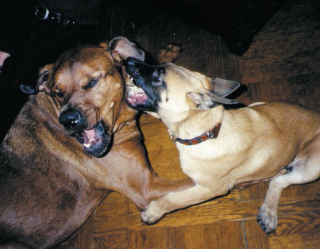
Many people have unrealistic expectations about dog-dog social behavior. Dogs are expected to behave perfectly and get along with all other dogs, even though people have difficulty being universally accepting and friendly. However, although people may often disagree, argue, and sometimes resort to pushing and shoving, very few people inflict severe injuries. When tempers flare, extreme physical aggression is strongly inhibited. Really, dogs are not that much different.
Most dogs have frequent disagreements and arguments, and on occasions resort to scrapping noisily, but only extremely rarely does one dog severely harm another. Whereas it is unrealistic to expect dogs never to squabble, it is perfectly realistic to raise and train dogs to never hurt each other when fighting.
To teach canine social savvy: first, socialize your puppy to be friendly, so that he would rather play than fight; second, prevent predictable adolescent de-socialization, but most important; third, teach your puppy bite inhibition, so that if he does scrap as an adult dog, he causes no harm.
Socialization
Socializing a young puppy is as easy as it is enjoyable. Enroll in an off-leash puppy class, visit different dog parks on a regular basis, and walk your puppy at least once a day. To socialize your puppy, he must meet unfamiliar dogs on a regular basis.
Prevent Developmental Desocialization
Adolescence is a particularly stressful time for young dogs, especially males, who are repeatedly harassed by older dogs, especially males. The ritualized harassment is both normal and necessary, allowing older dogs to put developing youngsters "in their place" before they are strong enough to compete on the social scene. Harassment is triggered by rude adolescent behavior and by extremely elevated testosterone levels in five- to eighteen-month-old adolescents. Castrating your puppy will prevent most harassment from older dogs.
Additionally, to maintain self-confidence and offset the stress of adult-doggy discipline, an adolescent dog requires many positive social interactions. Regular play sessions and repeated friendly encounters are vital. However, for many dogs, socialization with other dogs is abruptly curtailed at between six to eight months, usually following the first couple of scraps. This is especially true for small dogs and large dogs. Worrying that a little dog may get hurt, the owner is more likely to pick him up and less likely to let him play. Similarly, worrying a large dog might hurt other dogs, the owner now tends to keep her restrained on a tight leash. Thus, at a crucial developmental stage, many dogs are seldom allowed to interact with unfamiliar dogs. A vicious circle develops—the dog desocializes and his bite inhibition begins to drift, whereupon fights and potential damage now become more likely, making it even more difficult to socialize the dog.
To prevent your puppy from becoming asocial or antisocial during adolescence, he must continue to meet unfamiliar dogs on a regular basis. Always praise your puppy for meeting, greeting, and playing with unfamiliar dogs. Never take friendly behavior for granted. Always let your dog know that you are very happy when he is friendly. Throughout adolescence and adulthood, praise and reward your dog with food treats after every friendly encounter with another dog.
Bite Inhibition
Most dogs, especially males, are involved in a number of scraps during adolescence. If the dogs acquired good bite inhibition during puppyhood and learned how to resolve differences without causing harm, there is little, if any, damage. However, if the dogs did not learn bite inhibition as puppies, there may be substantial damage.
Dog fights are noisy and scary, and many owners insist: "He fights all the time and is trying to kill the other dogs!" It is essential to objectively assess which dogs are dangerous and which are not. Calculate the dog's fight/bite ratio by asking, "How many times has the dog fought?" and "How many fights warranted veterinary treatment for severe bites?" The observation (that the dog fights a lot of the time) and the assumption (that the dog is trying to kill other dogs) are quite contradictory. If the dog is trying to kill other dogs, then obviously he is not that good at it, since he has had numerous attempts and failed on every occasion. On the contrary, a large number of fights and the absence of injury, offers proof the dog is definitely not trying to kill other dogs. (If one dog were truly trying to harm another dog, the physical damage from a single incident would be extreme.) Certainly he is undersocialized but he has marvelous bite inhibition.
"Growl classes" provide an effective solution for scrappy dogs that have never harmed another dog. Owners can safely practice controlling their dogs in a controlled setting, and dogs may gradually rebuild their confidence so that eventually they may resume socialization and play.
For dogs that harm other dogs, common-sense and precautionary management are the only options. The dog should be kept on-leash and muzzled whenever on public property. Allowing a dog that harms other puppies and dogs the opportunity to interact with other dogs would be unfair, irresponsible, and potentially dangerous.
Bite inhibition is the key. The issue is not really whether dogs fight, but whether or not one dog harms another. Puppies that had ample opportunities to socialize, play-fight, and play-bite with other puppies usually develop good bite-inhibition. They learned how to inhibit the power of their jaws and consequently may resolve adulthood differences without causing harm. Bite inhibition can only safely be established during puppyhood. Giving your puppy the opportunity to develop good bite inhibition is the most important reason for enrolling in puppy class.
To learn more, read AFTER You Get Your Puppy and watch the Canine Aggression: Fighting DVD. To locate puppy classes and "growl classes" in your area, contact the Association of Pet Dog Trainers
HyperDog!
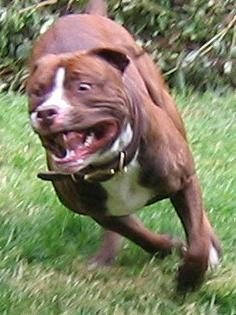
Puppies are naturally noisy and hyperactive. Puppies are exuberant when greeting, playing, and when expressing friendliness and appeasement. However, adult dogs are noisy and hyperactive because they are untrained and have unintentionally been encouraged to act that way. For example, eagerly jumping puppies are petted by people, who later get angry when the dog jumps up as an adult. The dog's only crime? It grew!
Sadly, adult dogs receive considerable abuse for expressing their enthusiasm and exuberance. For example, "The Trainers from the Dark Side" recommend teaching a dog not to jump up by shouting at the dog; squirting him in the face with water or lemon juice; swatting him on the nose with a rolled-up newspaper; yanking on the dog's leash; hanging the dog by his choke-collar; squeezing the dog's front paws; treading on his hind paws; kneeing the dog in the chest; or flipping the dog over backwards. Surely these methods are a bit cruel for a dog that's just trying to say hello. Indeed, in the words of Confucius, "There is no need to use an axe to remove a fly from the forehead of a friend." Why not just teach dogs to sit when greeting people?
Be smart. Be kind. Teach your puppy (or adult dog) to settle down and shush when requested and how to greet people in a mannerly fashion. Both dog noise and exuberance may be controlled and channeled into appropriate outlets.
Sit and Settle Down
Lure-reward train your puppy or dog to come, sit, and lie down. Simple instructions such as "Sit" and "Lie down" are extremely effective solutions for nearly all doggy activity problems. Rather than telling the pup "No, no, no!" and "NO!" for everything she does that annoys you, simply ask her to lie down, and then praise and reward her for doing so. If she lies down obediently, she cannot run around the living room, chase her tail, chase the cat, hump the cat, jump on the furniture, jump up and down in the car, run out the front door, or chase and jump on children. Lying down and most behavior problems are mutually exclusive; your dog cannot lie down and misbehave at the same time. Take the initiative and direct your puppy's behavior by teaching her to lie down on request.
Rather than feeding your puppy from a bowl, weigh out his kibble in the morning and use individual pieces as lures and rewards during oodles of five-second training interludes throughout the day. Practice in every room of the house, in the car (while stationary), and on walks. Pause every 25 yards and instruct your puppy to perform a series of body positions: for example, sit-down-sit-stand-down-stand. Within just a couple of days you'll have a totally different dog.
Simple reward training methods work wonders with out-of-control adolescent and adult dogs. Hold a piece of kibble in your hand but don't give it to your dog. Stand perfectly still and give no instructions; simply watch to see what your dog does. Characteristically, the dog will run through his entire behavior repertoire. Your dog will wiggle, waggle, circle, twirl, jump-up, lick, paw, back-up, and bark...but eventually he will sit or lie down. Praise him and offer the piece of kibble as soon as he sits (or lies down—your choice). Then take a gigantic step (to reactivate Rover), and stand still with another piece of kibble in your hand. Repeat the above sequence until Rover sits immediately after you take each step and then begin to progressively increase the delay before offering the kibble. Maybe count out the seconds in "good dogs"—"Good dog one, good dog two, good dog three, etc." If Rover breaks his sit while you are counting, simple turn your back on him, take a three-second timeout, and repeat the sequence again. In no time at all you will be able to count out 20 "good dogs" as Rover sits and stays calmly, looking up at you expectantly.
Move from room to room repeating this exercise. When walking Rover, stand still every 25 yards and wait for him to sit, then praise him and continue the walk. After handfeeding your dog just one meal in this fashion indoors and on one long walk with sits every 25-yards, you'll have a calmer and much more attentive dog.
Jumping Up
Jumping up deserves a special mention because it is the cause of so much frustration and abuse. Right from the outset, teach your puppy to sit when greeting people. Sitting is the obvious theoretical solution because a dog cannot sit and jump up at the same time. However, it may initially be difficult to teach your dog to sit when greeting people because he is so excited that he doesn't hear what you say. Consequently, you will need to troubleshoot his training.
First practice sits (as described above) in locations where your dog normally greets people, e.g., on-leash outdoors, and especially indoors by the front door. Then invite over ten friends for a dog training party. Today your dog's dinner will be handfed by guests at the front door and by friends on a walk. After eventually getting your dog to sit to greet the first guest, praise your dog and have the guest offer a piece of kibble. Then ask the guest to leave and ring the doorbell again. In fact, repeat front-door greetings until your dog greets the first guest in a mannerly fashion three times in a row. Then repeat the process with the other nine guests. In one training party you will probably practice over a hundred front-door greetings. Then ask your all your guests to leave one at a time and walk round the block. Put your dog on leash and walk around the block in the opposite direction. As you approach each person, instruct your dog to sit. Praise him when he does so and have the person offer a couple of pieces of kibble. After five laps, you will have practiced 50 sidewalk greetings. Now your dog will be ready to sit to greet bona fide guests at home and strangers on the street.
Put Doggy Enthusiasm and Activity on Cue
To be fair to your dog, make sure that she has ample opportunity to let off steam in an acceptable fashion. Sign up for flyball and agility classes. Play fetch with tennis balls and Frisbees and do yo-yo recalls (back and forth between two people) in the park. Formalize "crazy time"—train your dog to jump for bubbles, or play "tag" and chase your dog around the house. And maybe train your dog that it is acceptable to jump up on cue—to give you a welcome-home hug.
To learn more, read Doctor Dunbar's Good Little Dog Book. To locate puppy, adolescent, flyball, and agility classes in your area, contact the Association of Pet Dog Trainers at www.apdt.com .
Pulling on Leash
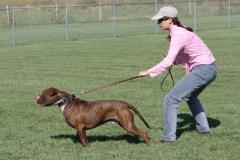
By and large, leash-pulling masks the real problem: without a leash you would probably be without a dog. It is indeed a sobering thought to think that most dogs prefer to forge ahead to sniff the grass or other dogs' rear ends than to walk by their owner's side. There are some dogs who simply don't want to walk beside owners who keeping yanking the leash. However, regardless of why your dog pulls, all dogs need to be trained to walk nicely on leash. If not, they are unlikely to be walked at all. Trying to teach a dog to heel using leash prompts and corrections requires a lot of skill and time. And even then, all you have is a well-behaved dog on-leash. Let him off-leash and he's history; you cannot safely take him for off-leash rambles, and you still cannot control him around the house, where he is off-leash all the time.
Luckily, there are more effective and enjoyable ways to get the job done. First, teach your dog to follow off-leash. Second. incorporate many sits and stays for control and attention. Third, teach your dog to heel off-leash and on-leash. After following these steps, you will find it is easier to teach your dog to walk calmly on-leash.
Teach Your Dog to Follow Off-Leash
Your dog's desire to follow and remain close is the necessary foundation for walking politely on-leash. You must become the center of your dog's universe. You need to stimulate and strengthen your dog's gravitational attraction towards you by moving away enticingly and heartily praising your dog all the time he follows. Click your fingers, slap your thigh, or waggle a food treat or a toy in your hand to lure the dog to follow. Proceed with a happy heart and a sunny disposition: talk to your dog, tell him stories, whistle, walk with a jaunty step, or even skip and sing.
Do not accommodate your dog's improvisations; you are the leader, not the dog. Whenever your dog attempts to lead, accentuate his "mistake" by doing the opposite. Stretch the psychic bungee cord: if your dog forges ahead, slow down or smartly turn about; if your dog lags behind, speed up; if your dog goes right, turn left; and if your dog goes left, turn right. Practice in large areas, such as in your backyard, friends' yards, tennis courts, dog parks, and safe off-leash areas. Feed your dog his dinner kibble, piece by piece as you walk. Once your dog is following closer, time yourself while practicing following-courses at home, going around furniture, from room to room, and from the house to yard.
Sits, Downs, and Stays
Enticing your dog to follow off-leash takes a lot of concentration and it is easy to let your dog drift. Consequently, instruct your dog to sit or lie down and then stay every ten yards or so. Frequent sits, downs, and stays teach your dog to calm down and focus. They also give you the opportunity to catch your breath, relax your brain, and to objectively assess your dog's level of attention. Sitting is absolute: either your dog is sitting or not. Only have the dog sit or lie down for a couple of seconds (just to check that he is paying attention) and then walk on again. Occasionally ask your dog to lie down for a minute or so to watch the world go by. You will find that the more down stays that you integrate into the walk, the closer, calmer, and more controlled your dog will be when following you.
Teach Your Dog to Heel Off-Leash & On-Leash
Instruct your dog to sit, and then lure him to sit using a food or toy lure in your right hand. Transfer the lure to your left hand, say "Heel," waggle the lure in front of your dog's nose, and quickly walk forwards for a few steps. Then say "Sit," transfer the lure to your right hand to lure your dog to sit, and maybe offer the kibble as a reward if your dog sits quickly and stylishly. Repeat this sequence over and over. Practice indoors and in your yard, where there are fewer distractions, before practicing in the dog park and off-leash walking areas. Then just attach the dog's leash and you will find he heels nicely on-leash.
Walking On-Leash
Teach your dog not to pull while you are both standing still. Hold the leash firmly with both hands and refuse to budge until your dog slackens the leash. Not a single step! It doesn't matter how long it takes. Just hold on tight and ignore every leash-lunge. Eventually your dog will stop pulling and sit. As soon as he sits, say "Good dog," offer a food treat, and then take just one large step forward and stand still again. Hold on tight; your dog will likely explode to the end of the leash, thereby illustrating the reinforcing nature of allowing your dog to pull for just a single step. Wait for your dog to stop pulling again (it will not take as long this time). Repeat this sequence until your dog walks calmly forward (because he knows you are only going one step) and sits quickly when you stop and stand still. Your dog quickly learns he has the power to make you stop and to make you go. If he tightens the leash, you stop. But if he slackens the leash and sits, you take a step. After a series of single steps and standstills without pulling, try taking two steps at a time. Then go for three steps, then five, eight, twelve, and so on. Now you will find your dog will walk attentively on a loose leash and sit automatically whenever you stop. And the only words you have said are "Good dog." Alternate heeling and walking on-leash. For most of the walk, let your dog range and sniff on a loose leash, but every 25 yards or so, have your dog sit, heel, and sit, and then walk on again. Always sit-heel-sit your dog when crossing a street: sit before crossing, heeling across, and then sitting on the other side of the street.
To learn more, read the Open Paw Four-Level Training Manual and Doctor Dunbar's Good Little Dog Book and watch the Training The Companion Dog DVD series.